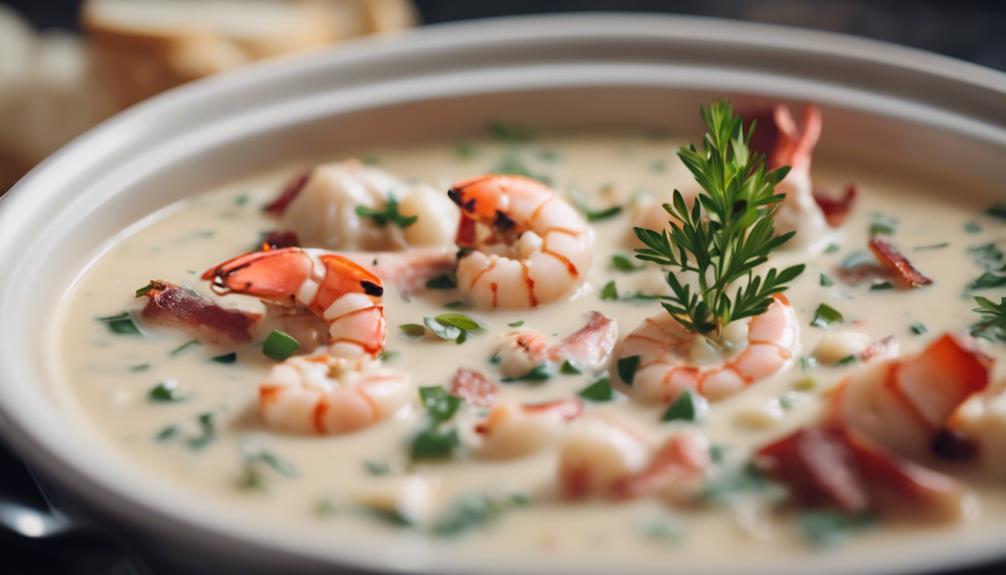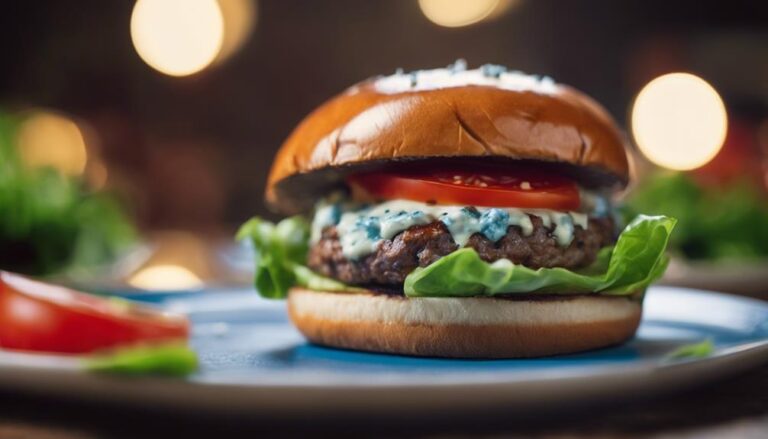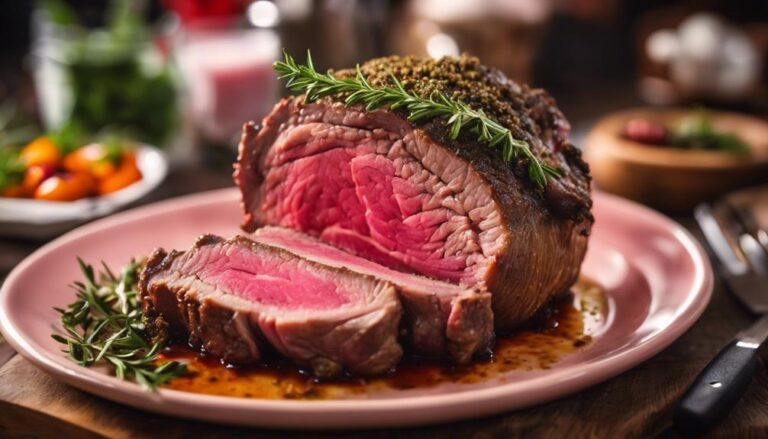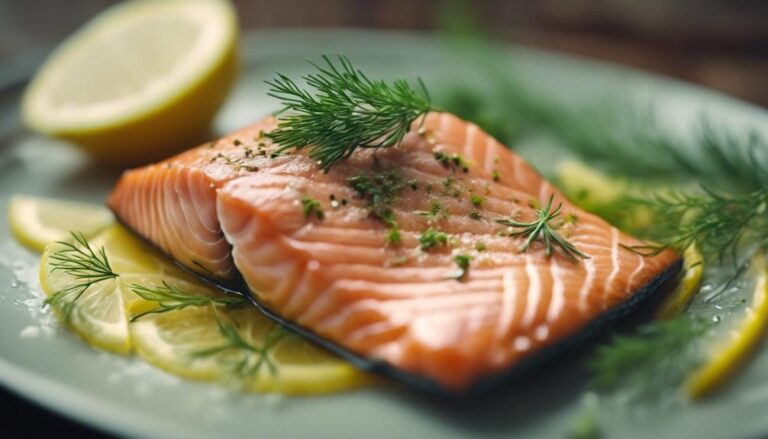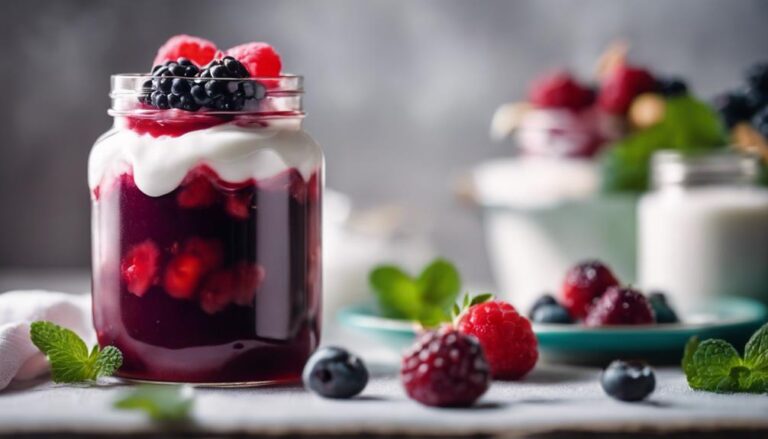Sous Vide Seafood Chowder
Immerse yourself in the refined art of Sous Vide Seafood Chowder for a culinary experience like no other. Harnessing the precise technique of sous vide, this chowder weaves together the delicate flavors of seafood with a touch of innovation. Let tender fish like cod shine at 120°F to 130°F, while robust shrimp or lobster thrive at 130°F to 140°F. With each succulent bite, savor the harmonious symphony of taste and texture. Uncover a world where precision meets tradition, offering a new level of culinary excellence. Elevate your palate with Sous Vide Seafood Chowder's exquisite flavors and textures.
What You Will Learn Here
- Sous vide cooking preserves seafood flavors.
- Achieve precise temperatures for tender seafood.
- Lock in natural juices without overcooking.
- Delicate fish like sole cooks at 120°F to 130°F.
- Firmer seafood like lobster at 130°F to 140°F.
Chowder's Origin
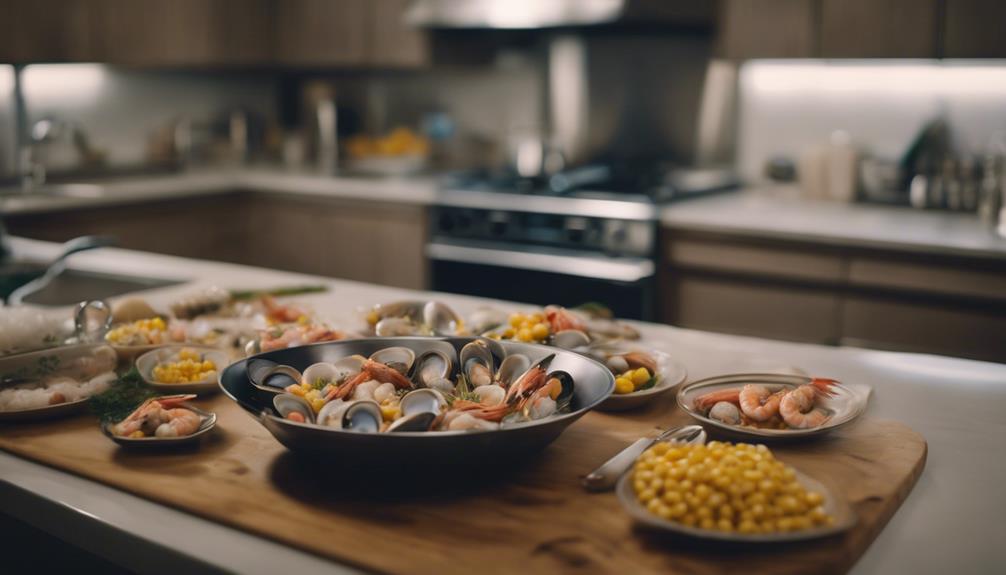
Let's journey through the rich tapestry of chowder's history, exploring its humble beginnings and the cultural influences that shaped regional variations.
From the traditional New England clam chowder to the innovative twists of modern culinary trends, chowder continues to evolve while remaining a beloved comfort food.
Uncover the stories behind this hearty dish that has captured the hearts and palates of many around the world.
Chowder's Historical Roots
Tracing back through history, delving into the origins of chowder reveals a rich culinary tradition that has evolved over centuries. Chowder's evolution showcases a deep connection to seafood sustainability, with recipes adapting to utilize available ingredients.
Cultural influences and seasonal ingredients have played pivotal roles in shaping the diverse variations of this hearty dish. From its humble beginnings as a simple fisherman's stew to its modern interpretations in fine dining, chowder remains a beloved comfort food cherished for its hearty flavors and comforting warmth.
Exploring the historical roots of chowder exposes a tapestry of culinary innovation and tradition that continues to inspire chefs and delight food enthusiasts around the world.
Regional Chowder Varieties
Exploring the origins of chowder reveals a diverse tapestry of regional varieties that showcase the unique culinary traditions of different locales. Chowder traditions are deeply rooted in the coastal communities of North America, with each region adding its own flair to this hearty dish.
From the creamy New England clam chowder to the tomato-based Manhattan style, chowder reflects the regional influences and ingredients available. Seafood pairing and flavor combinations play a significant role in shaping these distinct varieties.
Whether it's the use of fresh clams, fish, or shellfish, every region's chowder tells a story of the sea and the land. Embrace the rich history behind each bowl of chowder and savor the flavors that have been passed down through generations.
Modern Chowder Trends
As you ponder the rich tapestry of regional chowder varieties, a new wave of modern trends in chowder creation emerges, reshaping the traditional origins of this beloved dish.
Modern techniques are now being used to elevate chowder-making, blending traditional flavors with innovative culinary approaches.
Sustainable seafood practices have also become a cornerstone of modern chowder trends, emphasizing the importance of responsible sourcing and environmental stewardship.
Culinary innovation has led to the creation of chowders that not only delight the taste buds but also align with ethical values.
Key Chowder Components
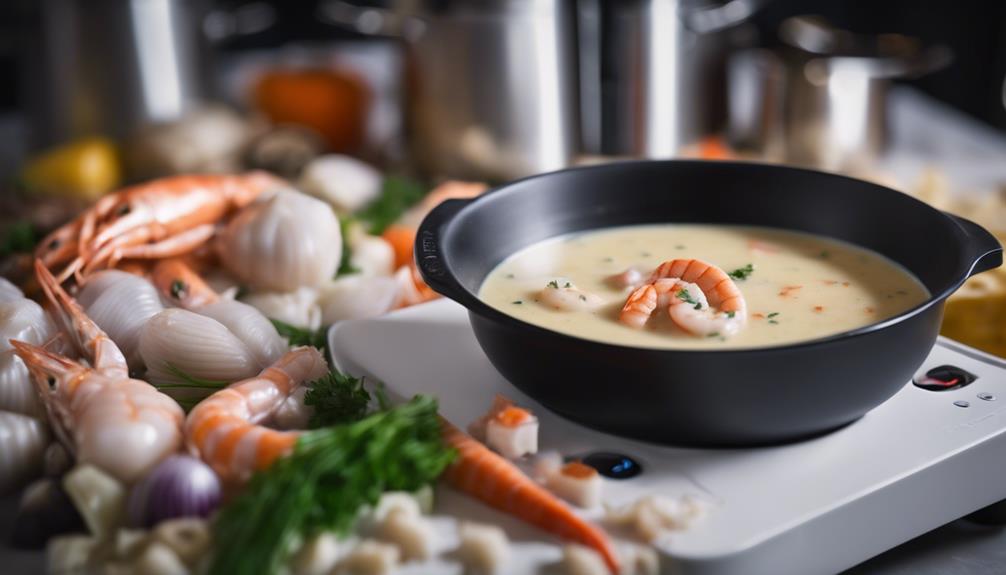
Consider incorporating these essential elements to elevate your seafood chowder.
- Ingredient Pairing: Select complementary seafood such as shrimp, scallops, and white fish for a dynamic flavor profile. The combination of these ingredients will create a rich and diverse seafood base that will satisfy even the most discerning palates.
- Flavor Profiles: Incorporate aromatic vegetables like onions, celery, and carrots to build a robust foundation for your chowder. Enhance the flavors with a hint of thyme and bay leaves, adding depth and complexity to the dish.
- Broth Consistency: Achieve the perfect balance between creamy and chunky by adjusting the consistency of your broth. Thicken it with a roux made from butter and flour for a velvety texture, or add cornstarch slurry for a gluten-free alternative.
Chowder Variations
Explore the flavorful world of chowder variations with tantalizing options like Sous Vide Lobster Bisque, Sous Vide Salmon Chowder, and Creamy Mussel Chowder.
These innovative twists on the classic seafood chowder offer a delightful array of tastes and textures to elevate your culinary experience.
With each variation showcasing unique ingredients and cooking techniques, you're in for a delectable journey through the diverse landscape of chowder possibilities.
Sous Vide Lobster Bisque
Enhance your culinary repertoire with a sumptuous twist by delving into the world of Sous Vide Lobster Bisque, a luxurious variation of the classic chowder. When preparing this exquisite dish, consider the following:
- Lobster Preparation: Begin by sous viding the lobster to perfection, ensuring a tender and flavorful base for your bisque.
- Flavor Infusion: Utilize the sous vide technique to lock in the rich flavors of the lobster, resulting in a depth of taste that traditional cooking methods often struggle to achieve.
- Sous Vide Benefits: Enjoy the benefits of precise temperature control and consistent results, guaranteeing a velvety smooth bisque every time.
Impress your guests with this refined take on a seafood classic, showcasing your culinary prowess with Sous Vide Lobster Bisque.
Sous Vide Salmon Chowder
Indulge in a culinary masterpiece with Sous Vide Salmon Chowder, elevating the traditional chowder experience with a luxurious twist. When preparing this divine dish, the salmon sous vide method guarantees a tender, succulent texture that perfectly complements the rich flavors of the chowder base.
Here's why this Salmon Chowder stands out:
- Delicate Fusion: The fusion of salmon sous vide and classic chowder ingredients creates a harmonious blend of flavors that will delight the palate.
- Elevated Sophistication: The use of salmon adds a touch of elegance to this seafood fusion, making it a perfect choice for upscale dining occasions.
- Nutrient-Rich: Salmon isn't only delicious but also packed with essential nutrients, making this chowder a wholesome and indulgent treat.
Creamy Mussel Chowder
Immerse yourself in the velvety richness of Creamy Mussel Chowder, a decadent twist on the classic seafood soup that promises to elevate your culinary experience. This luxurious chowder combines the creamy seafood base with the distinctive and savory Mussel flavors, creating a symphony of taste that will leave your taste buds dancing in delight.
Here is why Creamy Mussel Chowder stands out:
- Rich Creaminess: The velvety texture of the creamy seafood broth perfectly complements the briny essence of the mussels.
- Intense Mussel Flavors: Each spoonful bursts with the robust taste of fresh mussels, adding depth and complexity to the chowder.
- Harmonious Blend: The marriage of creamy seafood and mussel flavors creates a harmonious balance that's both comforting and indulgent.
Sous Vide Temperature Guide
When utilizing sous vide cooking techniques for your seafood chowder, understanding the ideal cooking temperatures is essential. Achieving precision in temperature control is key to ensuring the perfect doneness of your seafood.
Keep an eye out for indicators of seafood doneness to elevate your culinary skills to new heights.
Ideal Cooking Temperatures
To guarantee excellent outcomes in sous vide cooking, precise temperatures are essential for achieving the ideal texture and flavor in your dishes. When cooking sous vide shellfish, precise temperature control is paramount to make sure the seafood is perfectly cooked. Here is a guide to help you achieve the ideal cooking temperatures for some popular shellfish varieties:
| Shellfish | Ideal Temperature |
|---|---|
| Lobster | 140°F (60°C) |
| Shrimp | 130°F (54°C) |
| Scallops | 120°F (49°C) |
Precision Cooking Techniques
For precise and sophisticated sous vide cooking, mastering the ideal temperatures is key to achieving perfection in your dishes, especially when preparing various shellfish varieties.
Precision cooking techniques are essential for enhancing seafood flavors and ensuring that each bite is a culinary delight. When it comes to shellfish, such as lobster or scallops, maintaining precise temperatures using sous vide methods allows you to lock in the natural juices and flavors without overcooking.
Seafood Doneness Indicators
Master the art of sous vide seafood cooking by understanding the key indicators of doneness through a meticulously crafted temperature guide. Achieving the perfect seafood texture and taste requires precision.
When cooking seafood sous vide, remember that different types of seafood have varying ideal temperatures. For delicate fish like sole or cod, aim for 120°F (49°C) to 130°F (54°C) for a tender, flaky texture. Scallops should be cooked at 120°F (49°C) to 130°F (54°C) for a buttery consistency. For firmer seafood like shrimp or lobster, temperatures of 130°F (54°C) to 140°F (60°C) work best.
Final Thoughts
Consider reflecting on the delightful harmony of flavors in this Sous Vide Seafood Chowder as you savor the last spoonful. Exploring flavor profiles through sous vide cooking has truly elevated this dish to a new level of culinary excellence. The gentle cooking method of sous vide guarantees that each ingredient retains its distinct taste while melding together seamlessly to create a symphony of flavors in every bite.
When preparing this chowder, remember some essential sous vide cooking tips. Maintaining precise temperature control during the cooking process is essential to achieve the perfect texture and doneness of the seafood. Additionally, the airtight bags used in sous vide cooking help to infuse the ingredients with all the rich flavors, ensuring a depth of taste that's unparalleled.
As you conclude your dining experience with this exquisite seafood chowder, take a moment to appreciate the care and precision that went into each step of its creation. The balanced flavors, tender seafood, and creamy base all come together to offer a culinary masterpiece worth savoring.
Frequently Asked Questions
Can I Use Frozen Seafood for Sous Vide Seafood Chowder?
Yes, you can use frozen seafood for sous vide cooking. While fresh seafood is ideal, frozen options can work well too. Just make sure they are properly thawed before vacuum sealing for sous vide preparation to maintain best flavor and texture.
How Can I Thicken the Chowder Without Using Flour?
To thicken without flour, consider using potato starch or arrowroot powder in your chowder. Xanthan gum is another option. These alternatives can help achieve the desired consistency without compromising the dish's flavor.
What Are Some Creative Toppings for Seafood Chowder?
To elevate your seafood chowder, consider flavorful garnishes like crispy bacon bits or fresh chives. Enhance it with savory seasonings such as smoked paprika or a drizzle of truffle oil for a touch of luxury.
Can I Make a Dairy-Free Version of This Chowder?
You can create a dairy-free chowder by using dairy alternatives like coconut milk or cashew cream. These flavorful substitutions add richness and creaminess to your dish without compromising taste. Experiment with different options to find your favorite!
Is It Possible to Sous Vide the Chowder With Shellfish in the Shells?
You can sous vide mussels and other shellfish in their shells. The gentle cooking process will enhance the flavors and textures, creating a succulent dish. Make sure the shells are clean and tightly closed before cooking for best results.
Conclusion
Indulge in the rich and luxurious flavors of sous vide seafood chowder. This dish captures the essence of coastal cuisine with precision and elegance. With the sous vide technique, every bite is a symphony of perfectly cooked seafood and creamy broth, creating a culinary experience that's both innovative and satisfying.
Elevate your chowder game and impress your taste buds with this sophisticated twist on a classic favorite.
